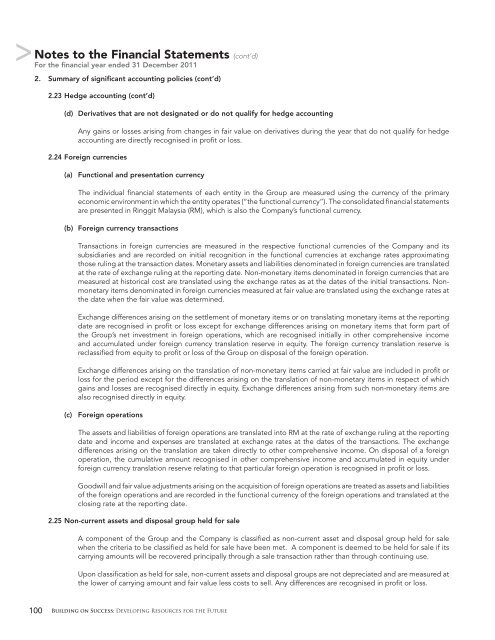Download PDF - ChartNexus
Download PDF - ChartNexus
Download PDF - ChartNexus
Create successful ePaper yourself
Turn your PDF publications into a flip-book with our unique Google optimized e-Paper software.
Notes to the Financial Statements (cont’d)<br />
For the financial year ended 31 December 2011<br />
2. Summary of significant accounting policies (cont’d)<br />
100<br />
2.23 Hedge accounting (cont’d)<br />
(d) Derivatives that are not designated or do not qualify for hedge accounting<br />
Any gains or losses arising from changes in fair value on derivatives during the year that do not qualify for hedge<br />
accounting are directly recognised in profit or loss.<br />
2.24 Foreign currencies<br />
(a) Functional and presentation currency<br />
The individual financial statements of each entity in the Group are measured using the currency of the primary<br />
economic environment in which the entity operates (“the functional currency”). The consolidated financial statements<br />
are presented in Ringgit Malaysia (RM), which is also the Company’s functional currency.<br />
(b) Foreign currency transactions<br />
Transactions in foreign currencies are measured in the respective functional currencies of the Company and its<br />
subsidiaries and are recorded on initial recognition in the functional currencies at exchange rates approximating<br />
those ruling at the transaction dates. Monetary assets and liabilities denominated in foreign currencies are translated<br />
at the rate of exchange ruling at the reporting date. Non-monetary items denominated in foreign currencies that are<br />
measured at historical cost are translated using the exchange rates as at the dates of the initial transactions. Nonmonetary<br />
items denominated in foreign currencies measured at fair value are translated using the exchange rates at<br />
the date when the fair value was determined.<br />
Exchange differences arising on the settlement of monetary items or on translating monetary items at the reporting<br />
date are recognised in profit or loss except for exchange differences arising on monetary items that form part of<br />
the Group’s net investment in foreign operations, which are recognised initially in other comprehensive income<br />
and accumulated under foreign currency translation reserve in equity. The foreign currency translation reserve is<br />
reclassified from equity to profit or loss of the Group on disposal of the foreign operation.<br />
Exchange differences arising on the translation of non-monetary items carried at fair value are included in profit or<br />
loss for the period except for the differences arising on the translation of non-monetary items in respect of which<br />
gains and losses are recognised directly in equity. Exchange differences arising from such non-monetary items are<br />
also recognised directly in equity.<br />
(c) Foreign operations<br />
The assets and liabilities of foreign operations are translated into RM at the rate of exchange ruling at the reporting<br />
date and income and expenses are translated at exchange rates at the dates of the transactions. The exchange<br />
differences arising on the translation are taken directly to other comprehensive income. On disposal of a foreign<br />
operation, the cumulative amount recognised in other comprehensive income and accumulated in equity under<br />
foreign currency translation reserve relating to that particular foreign operation is recognised in profit or loss.<br />
Goodwill and fair value adjustments arising on the acquisition of foreign operations are treated as assets and liabilities<br />
of the foreign operations and are recorded in the functional currency of the foreign operations and translated at the<br />
closing rate at the reporting date.<br />
2.25 Non-current assets and disposal group held for sale<br />
A component of the Group and the Company is classified as non-current asset and disposal group held for sale<br />
when the criteria to be classified as held for sale have been met. A component is deemed to be held for sale if its<br />
carrying amounts will be recovered principally through a sale transaction rather than through continuing use.<br />
Upon classification as held for sale, non-current assets and disposal groups are not depreciated and are measured at<br />
the lower of carrying amount and fair value less costs to sell. Any differences are recognised in profit or loss.<br />
Building on Success: Developing Resources for the Future
















